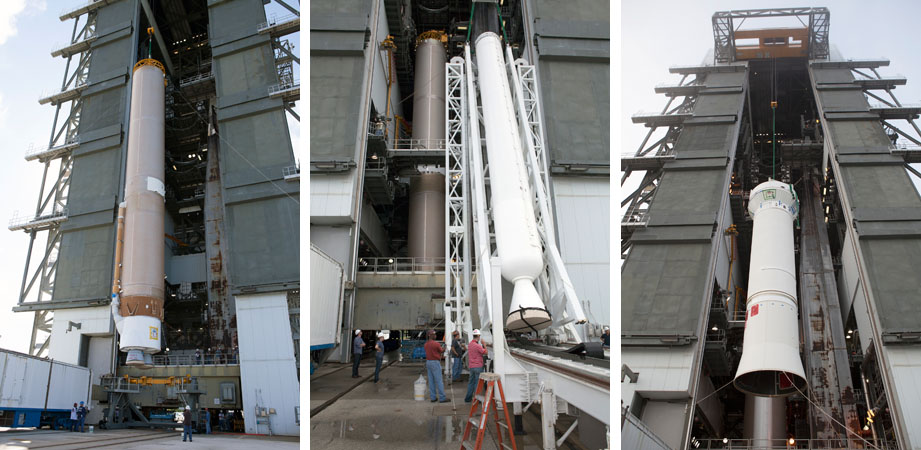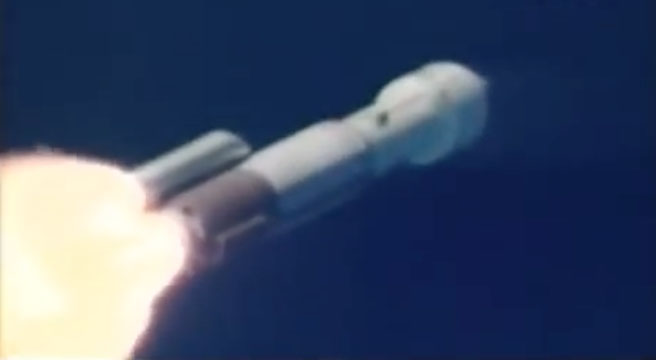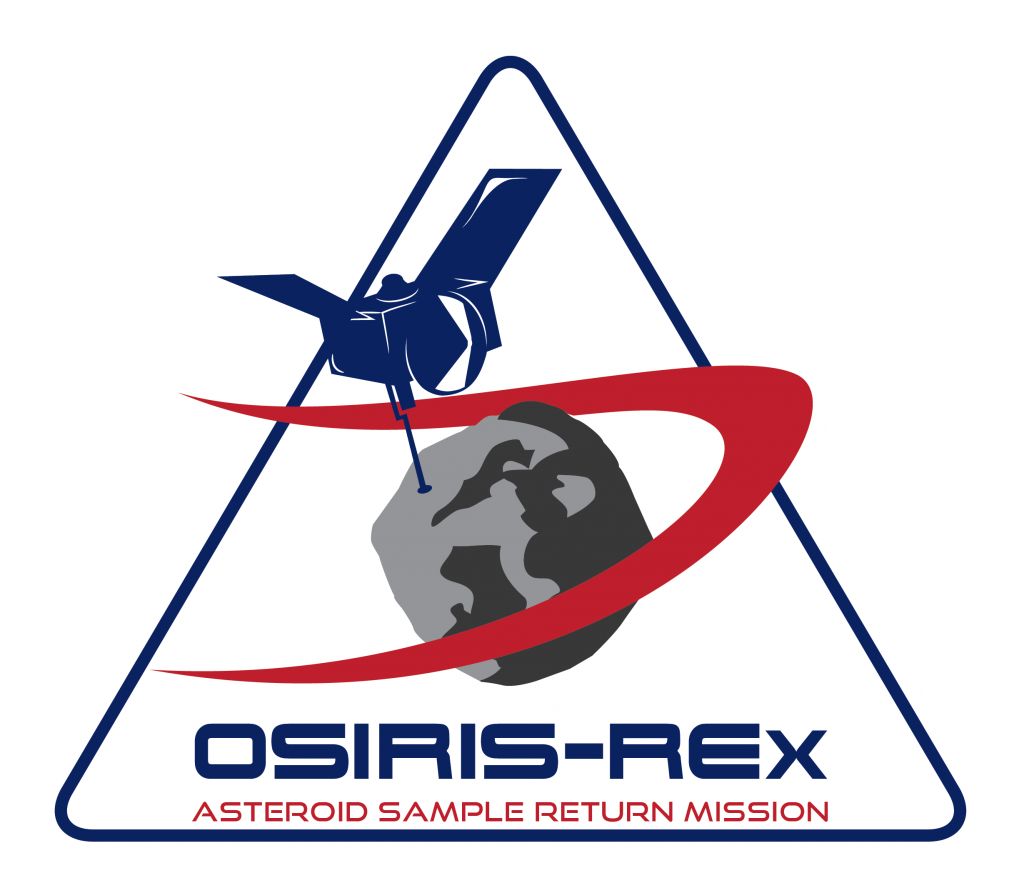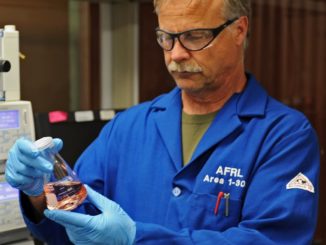
CAPE CANAVERAL — It is a rocket like no other, a vehicle with a single solid-fuel booster mounted to its side, that will launch NASA’s OSIRIS-REx probe next month to bring back a sample of Asteroid Bennu.
The United Launch Alliance Atlas 5 rocket in the unique 411 configuration, which has successfully flown three times before, is scheduled for liftoff Sept. 8.
Stacking of the vehicle aboard the mobile launch platform began with the first stage this morning at Cape Canaveral’s Vertical Integration Facility at Complex 41 for the much-anticipated mission.
The lone solid will be attached tomorrow and the pre-assembled interstage, Centaur upper stage and boattail will be lifted into place on Wednesday.
Initial powerup of the rocket occurs on Thursday and the Combined Systems Test, which is the critical electrical checkout of the vehicle, will follow next Monday, Aug. 15.
“From Monday to Monday, we should have the entire mechanical stack complete and the initial power sequence coupled with the Combined Systems Test. So it’s going to go pretty quick,” said Tim Dunn, NASA’s launch director for OSIRIS-REx from Kennedy Space Center’s Launch Services Program.

The strange-looking rocket is all part of the “dial-a-rocket” approach that designers took when creating the Atlas 5 family of vehicles to tailor each launch to the payload. The unconventional 411 variant is not too strong and not too weak, providing just the right amount of power for OSIRIS-REx.
The configuration is unique because rockets typically fly with either no strap-on boosters or multiple motors. While the appearance is stark, many Atlas 5 launches have flown successfully with uneven numbers of boosters attached to the first stage, like the 551 version with three on one side and two on the other.
The SRB’s stationary nozzle is oriented to mitigate the offset thrust, leaving the Atlas 5’s dual-nozzle main engine to provide the control authority to steer the rocket smoothly through the sky.
“It is unique and different,” said Dunn. “The first part of the question is why only one solid? The easy answer there is performance. We needed just a little more performance than the basic 401 could provide. The addition of one solid rocket booster satisfies that…and getting the mass of OSIRIS-REx on its way to the asteroid.
“Then, how do you fly with that one solid hanging off the side? In simplest terms, you let the flight control systems of the Atlas 5 sort it all out. It is a fixed nozzle on the solid strap-on but you have the two vectorable nozzles from the RD-180 engine. They can easily adjust slightly to offset that single thrust moment that is coming from one particular side of the Atlas 5.
“The actuators that steer the nozzles in the pitch and yaw directions, and can also roll the vehicle, they counteract the asymmetrical thrust from the single solid to enable the rocket to fly straight as we like it to.”

Three earlier 411 launches successfully lofted the commercial European TV satellite, called ASTRA 1KR, from Cape Canaveral in 2006 and two National Reconnaissance Office spy satellite deployment missions — NROL-28 and NROL-34 — from Vandenberg Air Force Base in 2008 and 2011. All were performed nominally.
The rocket will come off the pad with 1.2 million pounds of thrust from the RD-180 main engine and solid rocket booster. The lone SRB consumes all of its propellant in about 90 seconds, providing the Atlas 5 an added kick during the initial climb away from the planet. The spent casing then jettisons and leaves the first stage’s main engine to continue burning until about four minutes into flight before it separates from the Centaur upper stage.
After two burns by the Centaur, lasting 8 minutes to reach a parking orbit and then 7 minutes to escape onto the interplanetary trajectory, NASA’s OSIRIS-REx will separate an hour into the launch to begin its 7-year, roundtrip voyage to collect a sample of Asteroid Bennu and return it to scientific laboratories on Earth.
“We are very excited at participating in a mission bringing a sample of an asteroid back to Earth. That is very exciting,” Dunn said.

The spacecraft has a tight launch window stretching to Oct. 12 to depart Earth or it will miss the planetary alignment between Earth and Bennu for a year.
To ensure the rocket will be ready, crews will move the Atlas-Centaur vehicle from its assembly building to the launch pad on Tuesday, Aug. 23 for a countdown rehearsal and fueling exercise on Wednesday, Aug.24. The Wet Dress Rehearsal is meant to uncover any technical problems that need addressed before the actual launch day.
ULA eliminated WDRs for East Coast launches of its Atlas 5 rocket, saving nearly a week of processing time, except for specific NASA missions that must fly in planetary alignment windows.
“We have an actual option in the contract for our planetary missions where we can turn on the ability to do the WDR,” Dunn said. “And what that does is it buys down risk early. If we find something during Wet Dress Rehearsal, it beats finding it on the day of launch.”
While the WDR is going on, OSIRIS-REx will be encapsulated within the rocket’s aluminum nose cone at KSC’s Payload Hazardous Servicing Facility. The fairing is 14 feet in diameter and 39 feet long.
After WDR, the rocket then returns to the Vertical Integration Facility on Thursday, Aug. 25 to await attachment of the OSIRIS-REx payload on Monday, Aug. 29. The 4,650-pound spacecraft, already shrouded in the fairing, will be hoisted into the VIF and mated to the Centaur.
“Once we get clear of the Wet Dress Rehearsal, then we know we are ready to bring the spacecraft out,” Dunn said.
The tip-to-tail electrical check of the Atlas 5 rocket and the mated OSIRIS-REx spacecraft — called the Integrated Systems Test — is planned for Wednesday, Aug. 31.
The Flight Readiness Review occurs on Thursday, Sept. 1 to assess the progress of work and any outstanding issues, followed by the Mission Dress Rehearsal for control room staff on Friday, Sept. 2 and then a quiet Labor Day Weekend of just monitoring spacecraft health.
The Launch Readiness Review to give approval to proceed with the mission is scheduled for Tuesday, Sept. 6.
The fully assembled vehicle standing 189 feet tall will be rolled out to the pad on Wednesday, Sept. 7 for the countdown and launch on Thursday evening, Sept. 8.

There will be 25 opportunities to launch OSIRIS-REx each day. The rocket will have distinct shots to fly every five minutes during a two-hour window.
The daily window always opens around 7 p.m. EDT (2300 GMT) and extends two full hours for all but a few days.
Given the time-critical nature of the launch, the Air Force-controlled Eastern Range has reserved three consecutive days for OSIRIS-REx instead of the usual two days before negotiating for more, if needed.
*Sept. 8: 7:05 to 9:05 p.m. EDT (2305-0105 GMT)
*Sept. 9: 7:10 to 9:10 p.m. EDT (2310-0110 GMT)
*Sept. 10: 7:05 to 9:05 p.m. EDT (2305-0105 GMT)
“The way targeting works, if we tried to launch at any time for this mission during the window, you would have 60 opportunities per minute, then 60 minutes per hour, times two. There would have been a whole lot of cases to analyze. To make it easier on ourselves with a two-hour window, we broke it into five-minute blocks,” Dunn said.
Statistically, a two-hour window for Atlas 5 provides a strong likelihood of getting off the ground.
OSIRIS-REx will rendezvous with the Near-Earth Object Bennu two years after launch and slip into orbit around the asteroid to conduct nearly a year of surveying work with its instruments to map the chemistry and mineralogy of the carbon-rich body.

The craft carries a camera suite that will document the asteroid, search for moons, image in color and features an 8-inch telescope, a laser altimeter to map the shape of Bennu, a thermal emission spectrometer for mineral and temperature data, a visible and infrared spectrometer to identify organic material and a student-made X-ray imaging spectrometer that seeks to determine what elements are present on the asteroid’s surface.
Then, on July 4, 2020, the small probe will use its 11-foot-long robotic arm to grab a specimen of the celestial object with a 0.22 mph touch-and-go maneuver. The spacecraft will obtain at least 2.1 ounces and possibly up to 4.4 pounds of regolith.
Once stowed in the protective return capsule, OSIRIS-REx will leave Bennu in 2021 for a two-year journey back home to make a parachute-assisted landing on Earth in September 2023 at the Utah Test and Training Range.
The mission hopes to gain definitive proof of what the conditions were like in the earliest stages of the solar system through the pristine material brought back by OSIRIS-REx, the first U.S.-led asteroid sample return mission.
Lockheed Martin built OSIRIS-REx, which stands 10 feet tall and will be 20 feet wide once its power-producing solar arrays are deployed in space.
The mission is led by the University of Arizona and Principal Investigator Dante Lauretta. The Goddard Space Flight Center manages the mission for NASA.
This will be the 65th Atlas 5 rocket launch since 2002. In its 64 previous missions, the Atlas 5 has flown 25 flights dedicated to the Defense Department, 14 commercial missions, 13 for the National Reconnaissance Office and 12 for NASA.
See earlier OSIRIS-REx coverage.
Our Atlas archive.



